Biostats Unit 1
1/78
There's no tags or description
Looks like no tags are added yet.
Name | Mastery | Learn | Test | Matching | Spaced |
|---|
No study sessions yet.
79 Terms
Inferential statistics
reach decisions about a large body of data if all we have is a small part
Data
raw material of statistics
Statistics
a field of study concerned with:
1) Collection, organization, summarization, & analysis of data
2) the drawing of inferences about a body of data when only a part of the data is observed
3) interpret & communicate results
an estimated value calculated from a sample, varies from sample to sample
Where do we get data?
1) Routinely kept records
2) Surveys
3) Experiment
4) External sources
Variable
If a characteristic takes on different values in different persons, places, things
Quantitative variable
One that can be measured in the usual way & has units. Conveys info about an amount (does it make sense to find the avg?)
Best graphs:
✅ Histogram (especially for large data sets)
✅ Box-and-whisker (for comparing medians and outliers)
✅ Dotplot (good for small datasets)
✅ Stem-and-leaf (also good for small to medium datasets)
Qualitative variable
one that has categories
-we count the # in each category, called the frequency
exp: eye color, ethinic group, medical diagnoses
-Bar graph best for this type of data
Random variable
when the values arise as a result of chance factors & so can’t be predicted
Observations/measurements
Values from the measurement procedure
Discrete variable
characterized by gaps or interruptions in the values that it can assume
exp: coin flip (heads or tails)
-# of pts seen each day
Continuous random variable
-doesn’t posses any gaps or interruptions
-it can assume any value within a specified relevant interval of values
-e.g: weight, height, wrist circumference
Population
the collection of all entities for which we have an interest
-entities=cases=units
Population of values
-measurement of a variable on each of the entities we generate
N
size of the finite population (fixed # if values/entities)
Infinite population
if there are an endless # of values
Parameter (fixed #)
an exact value calculated from a pop
Sample
a part of the pop
-we use n=size of sample
Measurement
an assignment of #s to objects or events according to a set of rules
-various scales result from the different rules
Nominal scale
Definition: Categorizes data without any order or ranking.
Examples: Gender, blood type, types of bacteria, colors.
How to Identify: Look for data that are names, labels, or categories without a meaningful sequence.
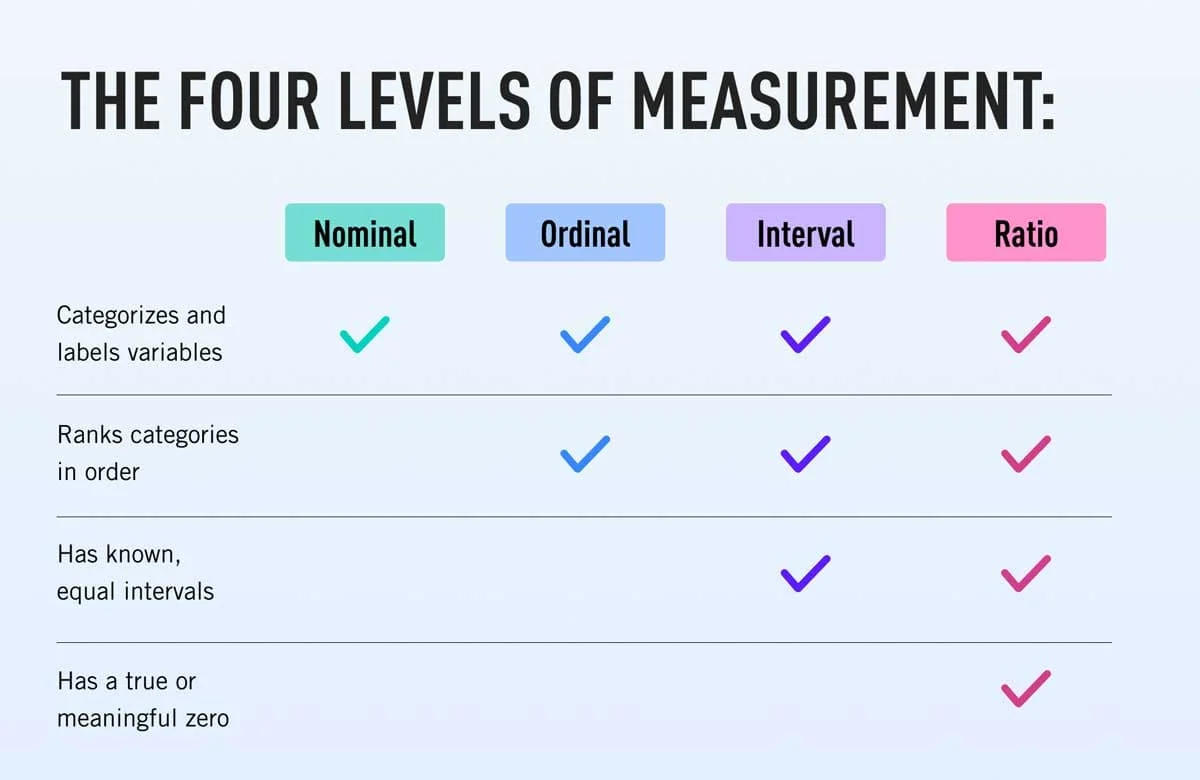
Mutually exclusive
in 1 & only 1 category or group
Collectively exhaustive
all possible categories are listed
Ordinal scale
Definition: Categorizes data with a meaningful order, but the intervals between categories are not equal.
Examples: Pain severity (mild, moderate, severe), class rank, stages of cancer.
How to Identify: Look for rankings or ordered categories where the difference between ranks isn’t uniform.
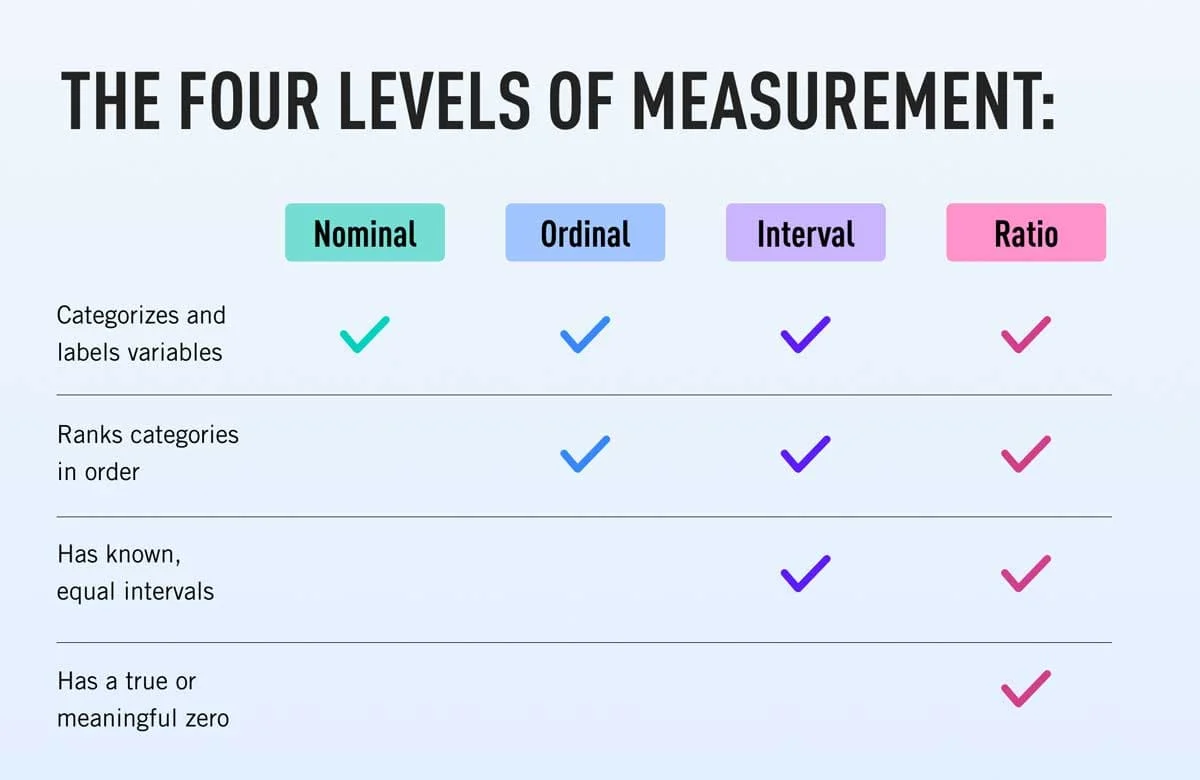
Interval scale
Definition: Numerical data with equal intervals between values but no true zero point.
Examples: Temperature in Celsius or Fahrenheit, dates on a calendar.
How to Identify: Check for numeric data where subtraction makes sense, but there’s no absolute zero (e.g., 0°C doesn’t mean “no temperature”).
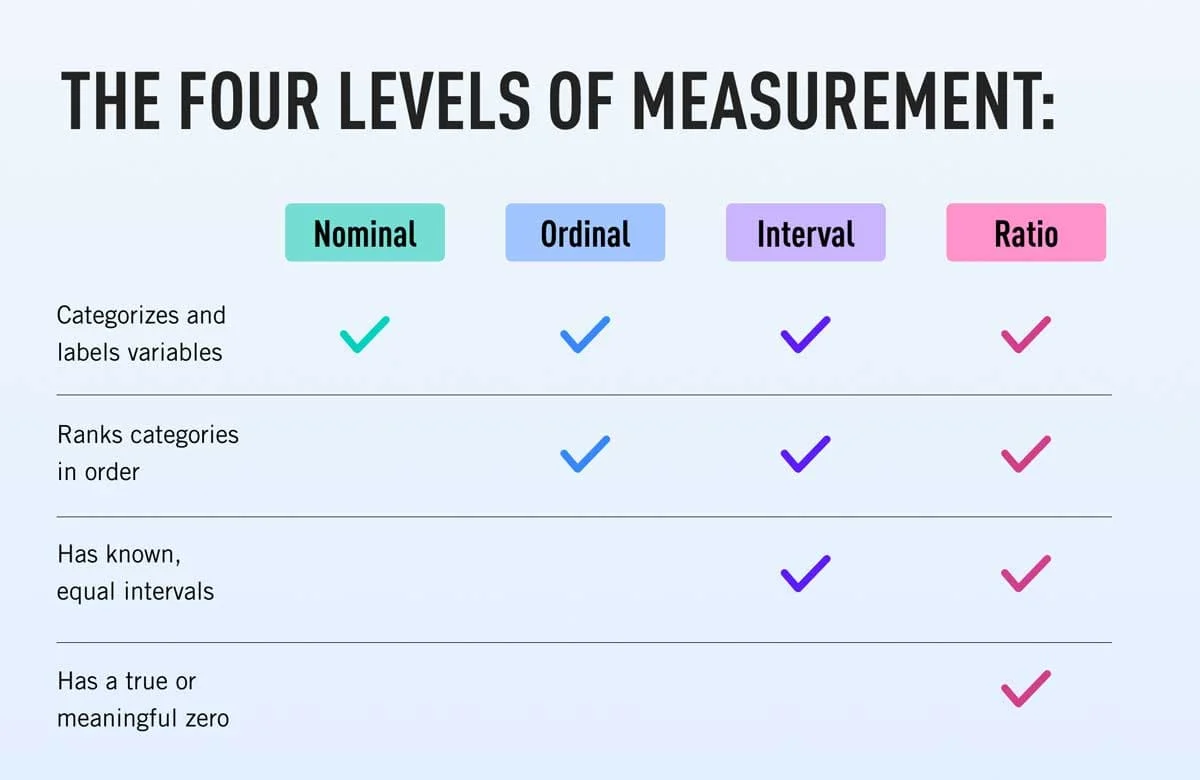
Ratio scale
Definition: Numerical data with equal intervals and a true zero, allowing for meaningful ratios.
Examples: Height, weight, age, enzyme activity, heart rate.
How to Identify: Look for numeric data with a true zero (e.g., 0 means none of the quantity), and ratios make sense (e.g., 20 kg is twice as heavy as 10 kg).
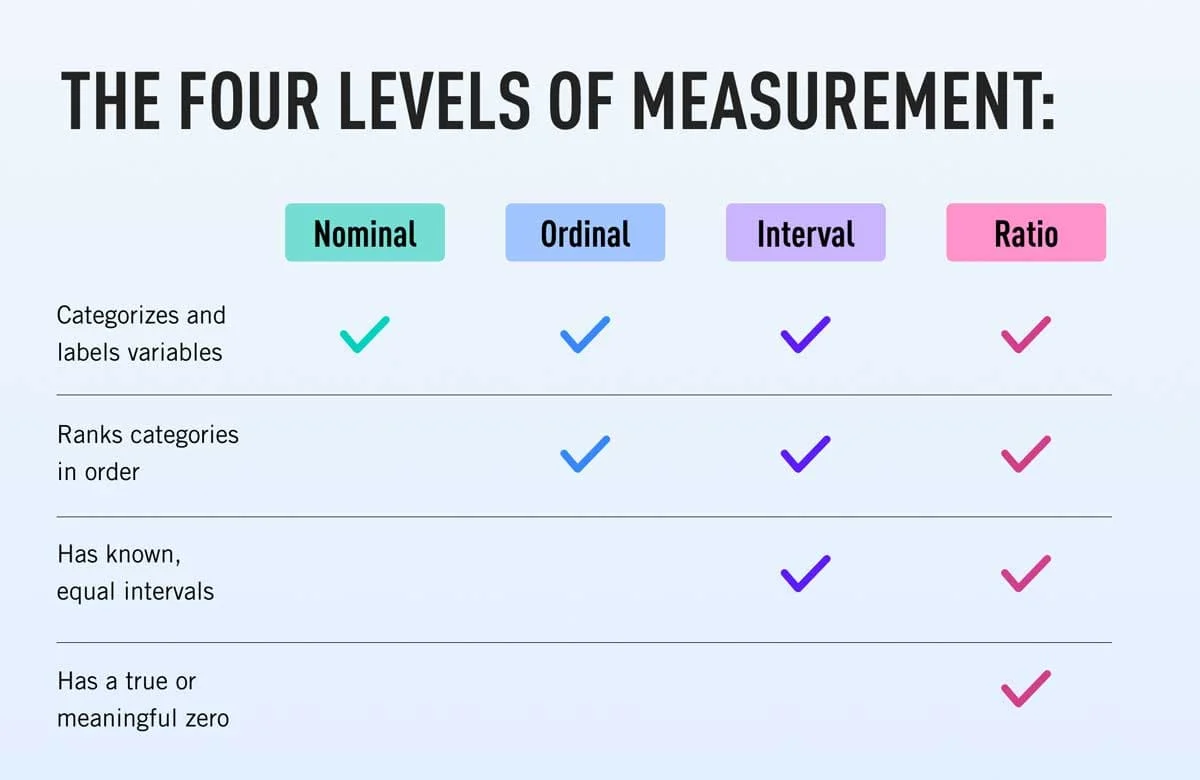
Simple random sample
If a sample of size n is drawn from a pop of size N in such a way that every possible sample of size n has the same chance of being selected
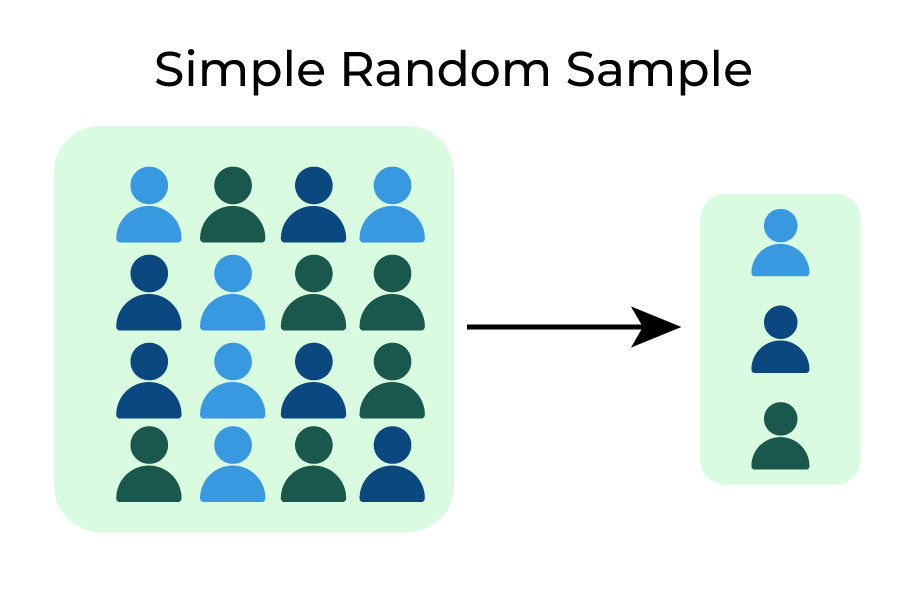
Sampling with replacement
every member of the pop is available at draw
-every member could be selected again (& again)
Sampling w/o replacement
we would not record the value of the variable for any member that has already been selected
-usually do this
Research study
a scientific study of a phenomenon of interest. Involves designing the sampling protocols, collecting & analyzing the data, & providing valid conclusions based on the analysis
Experiment
a special type of research study in which observations are made after specific manipulations of conditions have been done
Systematic sampling
used in health sciences calculate total number of records needed for study
-use a random # as starting point —> call it record x
-pick a second, calculated by # of records desired, to get the sampling interval, use K
-Data in sample: x, x + k, x +2k, etc.,
Scientific method
a process by which scientific info is collected, analyzed & reported in order to produce unbiased & replicable results in a effort to provide an accurate representation of the observable phenomena
Ordered array
A listing of the values of a collection (set) in order of magnitude from smallest to largest (in population or sample)
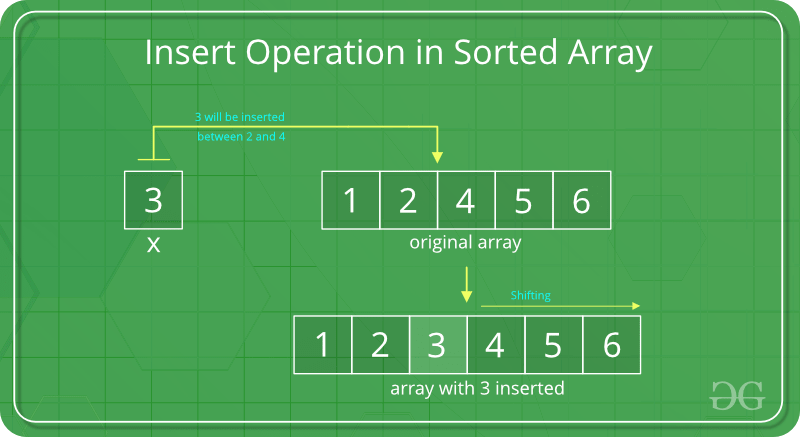
Relative frequency of occurrence
proportion of values falling in each class
Measure of central tendency
a single value that is considered typical of the set of data, i.e, the “average” value
There are 3: mean (avg), median, mode
(Useful) properties of mean
1) Uniqueness: for a given set of data, there is 1 & only 1 mean
2) Simplicity: easy to calculate & understand
3) Since each & every data value is used (good), however extreme values can have an undue influence on the mean
Skewed
If the graph (histogram or frequency polygon) of a distribution is asymmetric, the distribution is said to be
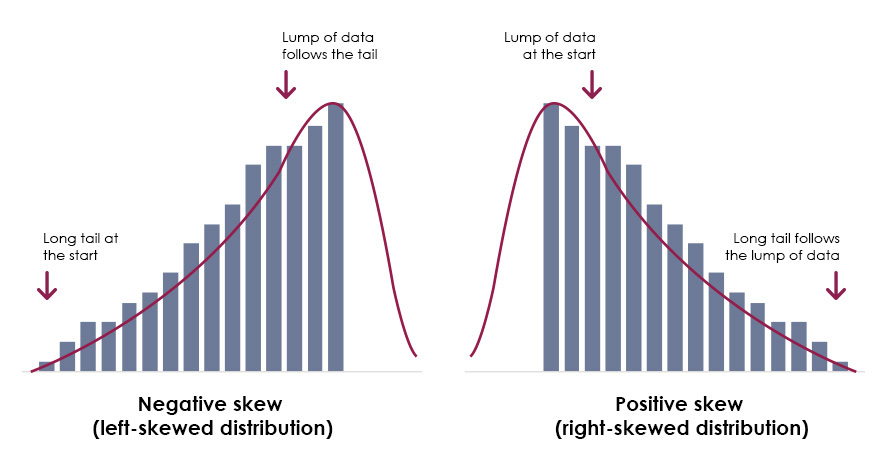
Positively skewed/skewed to the right
If a distribution is not symmetric because it has a long tail to the right, we say that the distribution is
-if the mean is greater than the mode
-the mean is larger than the median because the extreme high values pull the mean to the right, while the median remains near the center of the data.
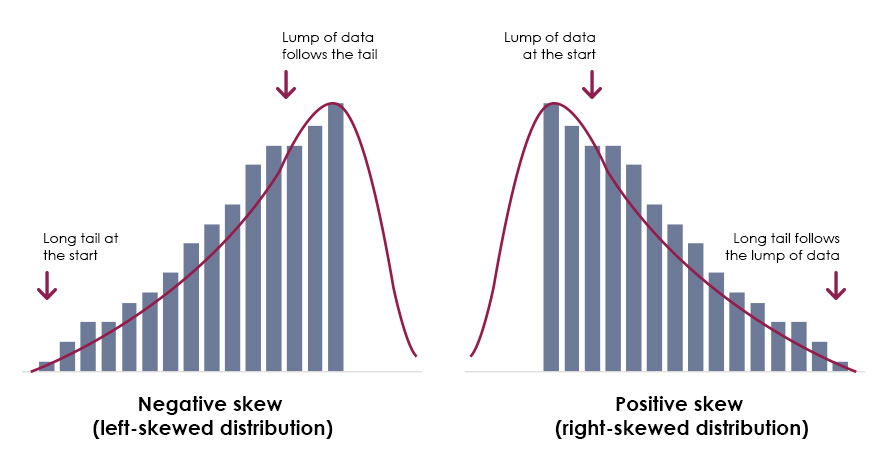
Negatively skewed/skewed to the left
If a distribution is not symmetric because its graph extends further to the left than to the right, that is, if it has a long tail to the left, we say that the distribution is
-mean is less than mode
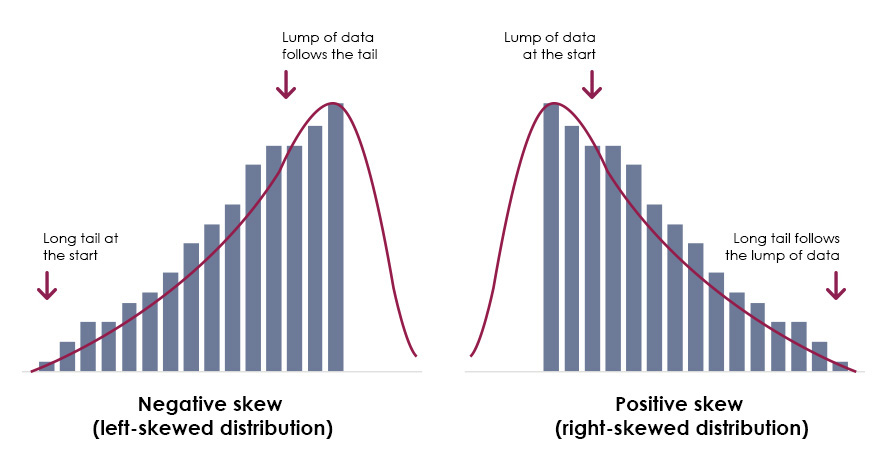
Dispersion
refers to the variety that they exhibit
-conveys information regarding the amount of variability present in a set of data. If all the values are the same, there is none; if they are not all the same, it is present in the data
-values are widely scattered—> it is greater
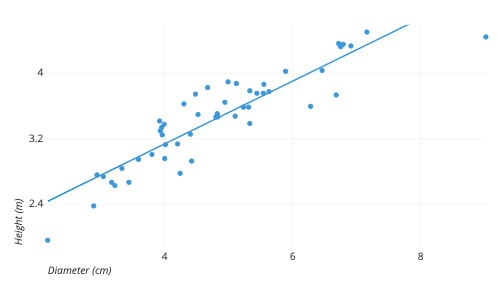
Interquartile range (IQR)
the difference between the third and first quartiles
-Q3-Q1
A large value indicates a large amount of variability among the middle 50% of the relevant observations, and a small value indicates a small amount of variability among the relevant observations
Kurtosis
a measure of the degree to which a distribution is “peaked” or flat in comparison to a normal distribution whose graph is characterized by a bell-shaped appearance.
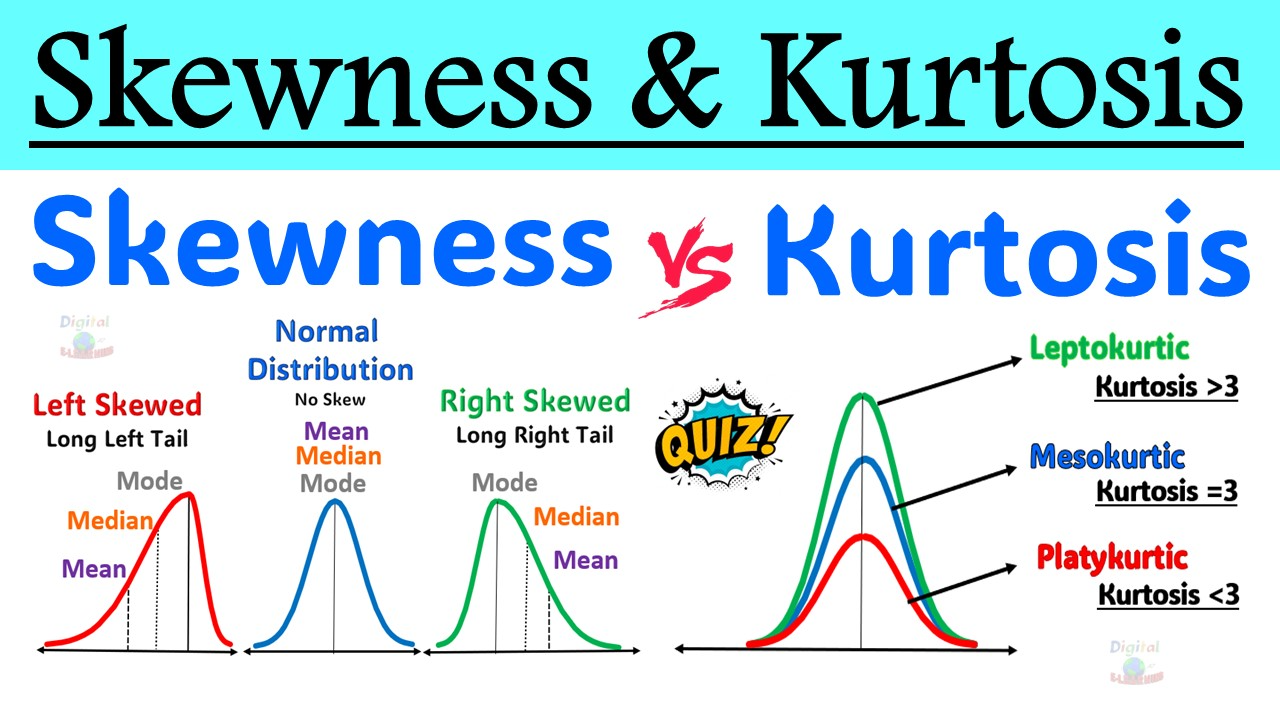
Outlier
a data point that differs significantly from other observations
Objective probability
comes from objective processes
2 divisions: classical or relative frequency
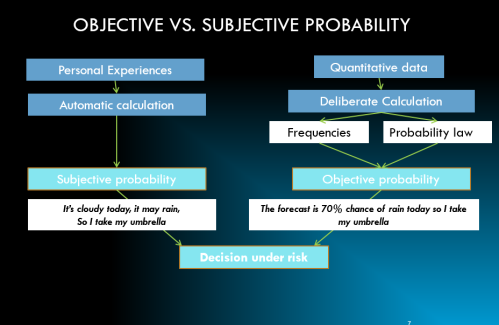
Classical probability
-(a priorirprobability) is based on counting theory & the idea that each event are equally likely to occur
Relative frequency probability
( a posteriori or experimental)
is based on the repeatability of same process & the ability to count the # of repetitions & the # of times the event of interest occurs

Subjective probability
holds that probability measures the confidence that an individual has in the truth of a particular proposition. Does not need repeatability, can be used for an event that might only happen once
-We use Bayesian methods
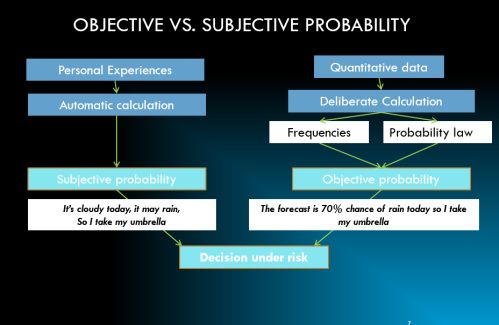
Prior probability
of an event is probability based on prior knowledge, prior experience, or results from prior data collection
Posterior probability
of an event is probability obtained by using new information to update or revised prior probability
Conditional probability
When probabilities are calculated with a subset of the total group as the denominator
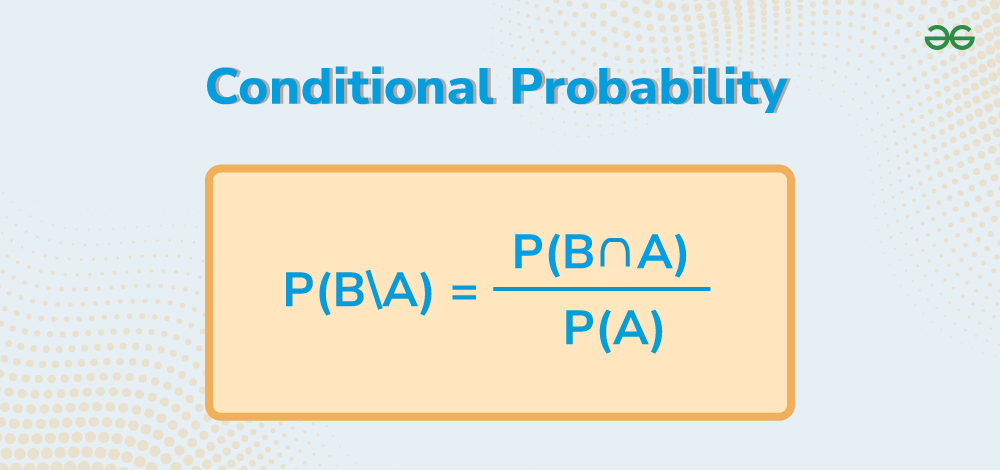
Joint probability
Sometimes we want to find the probability that a subject picked at random from a group of subjects possesses two characteristics at the same time.
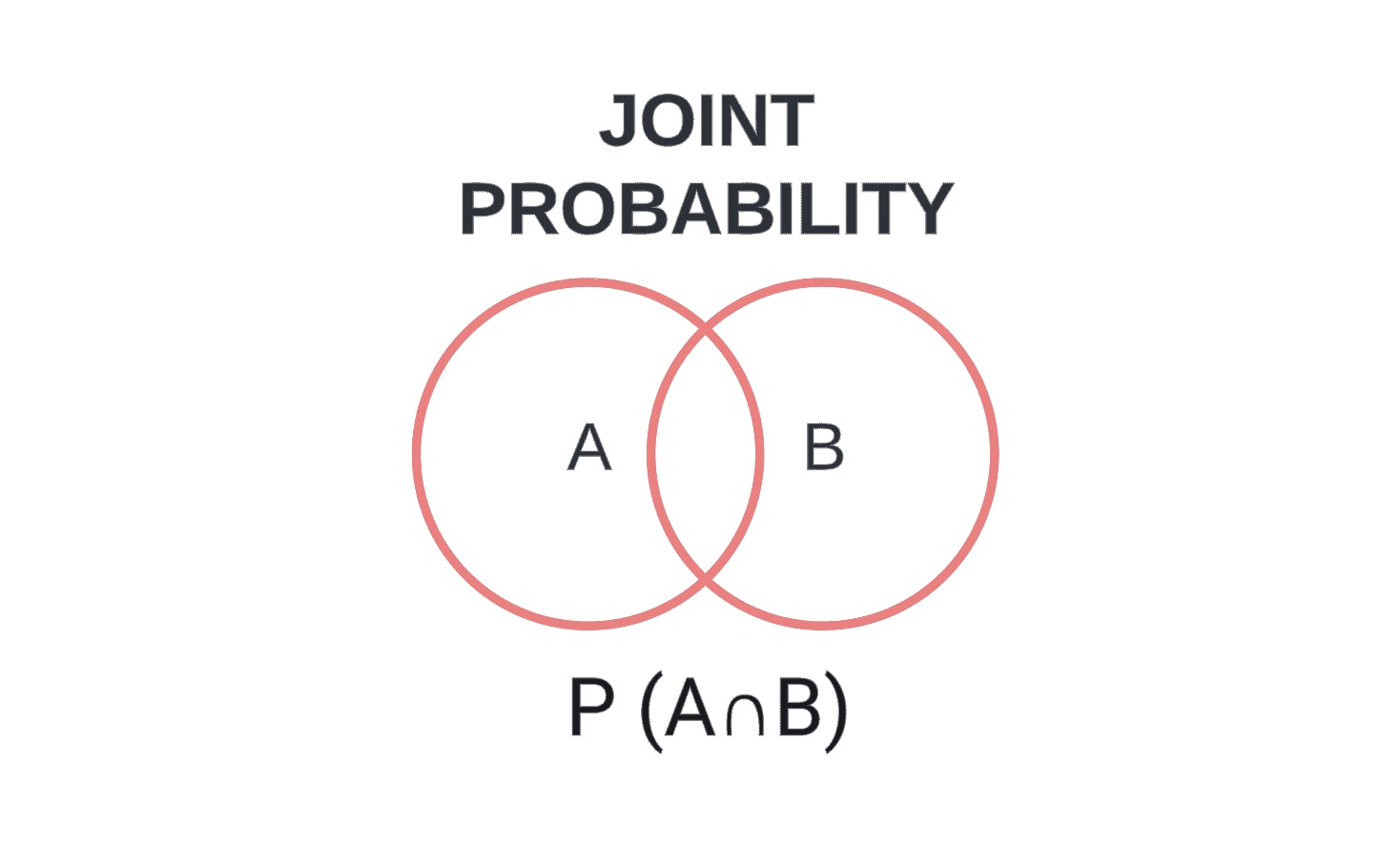
Descriptive statistics
provide simple summaries about the sample and about the observations that have been made. Such summaries may be either quantitative, i.e. summary statistics, or visual, i.e. simple-to-understand graphs.
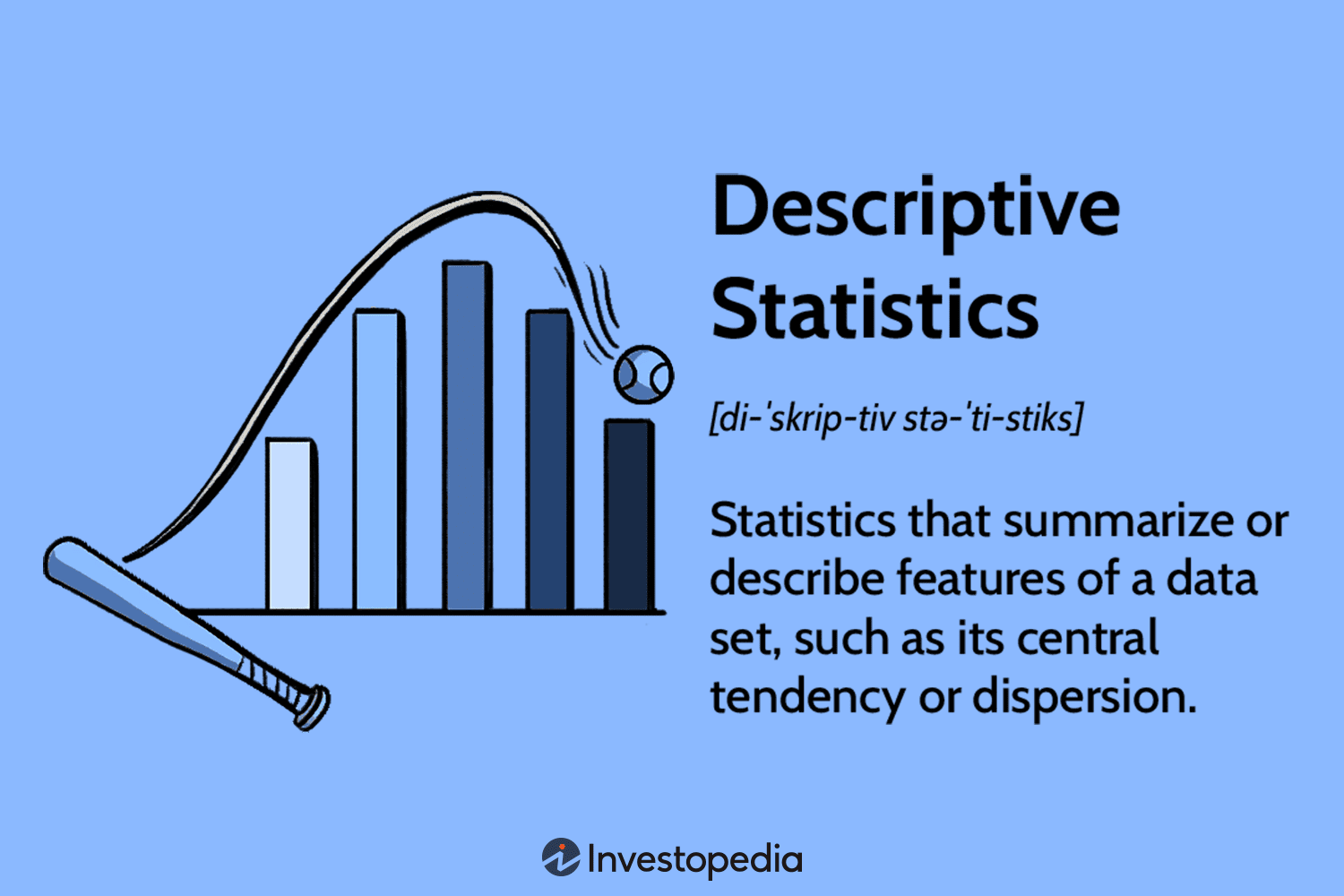
Biostatistics
a field of study that uses statistical methods to analyze data related to living organisms.
Stratified sampling
researchers divide subjects into subgroups called strata based on characteristics that they share (e.g., race, gender, educational attainment). Once divided, each subgroup is randomly sampled using another probability sampling method.
Identify Strata (Groups):
Group students by class standing: Freshmen, Sophomores, Juniors, Seniors.
Determine the Population Size (N):
N=100N = 100N=100 students.
Decide the Sample Size (n):
n=20n = 20n=20 students.
Determine the Proportion from Each Stratum:
Freshmen: 40/100×20=8 students.
Sophomores: 30/100×20=6 students.
Juniors: 20/100×20=4 students.
Seniors: 10/100×20=2 students.
Randomly Select Students from Each Stratum:
Randomly select 8 Freshmen.
Randomly select 6 Sophomores.
Randomly select 4 Juniors.
Randomly select 2 Seniors.
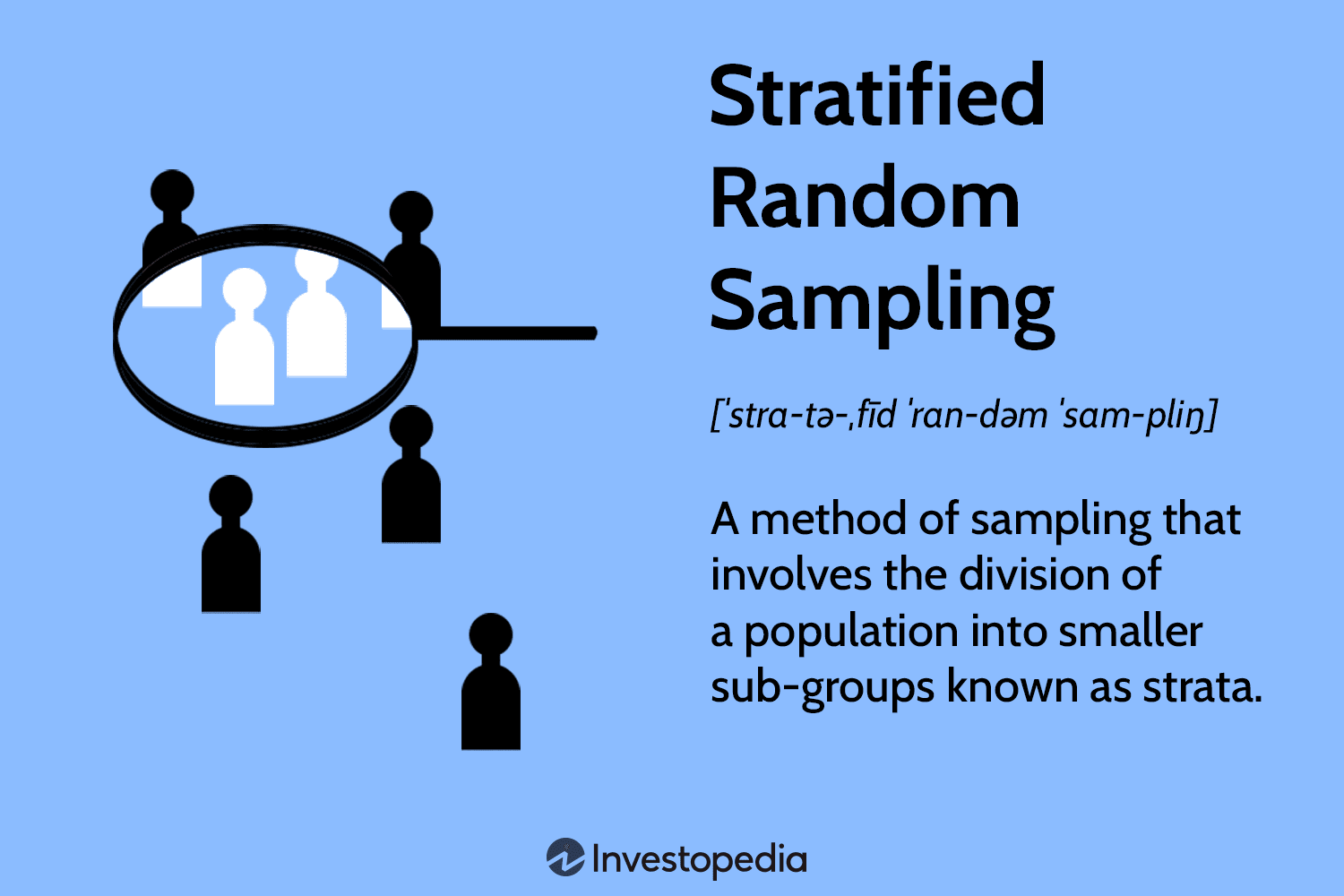
Stem-and-leaf display
a method of visualizing data by splitting each data point into two parts: a "stem" representing the leading digits and a "leaf" representing the last digit
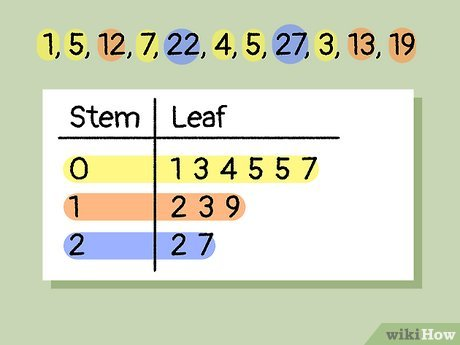
Box and whisker plot
a visual representation of data distribution that displays the minimum, first quartile, median, third quartile, and maximum values of a dataset using a box with lines extending outwards ("whiskers") to show the spread of the data, including potential outliers
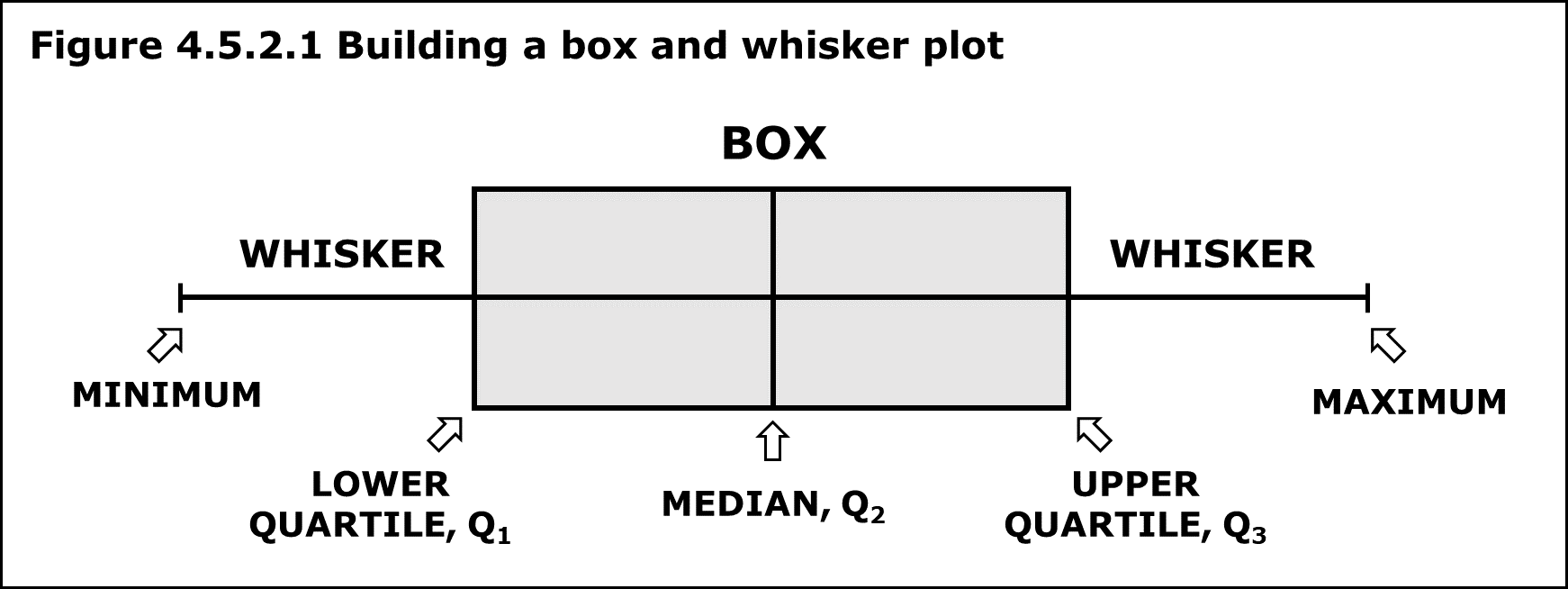
Location parameter
a statistical measurement that indicates the center of a distribution
Common ones:
Mean: The most common location parameter, often represented by the symbol μ
Median: The value in the middle of ordered values
Mode: The most common value in a distribution
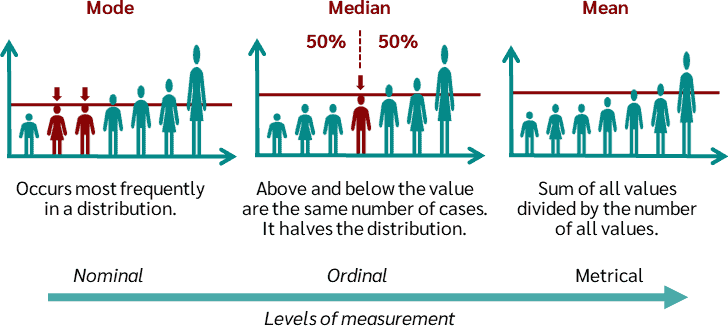
Frequency distribution
a graph or table that shows how often a value occurs in a data set.
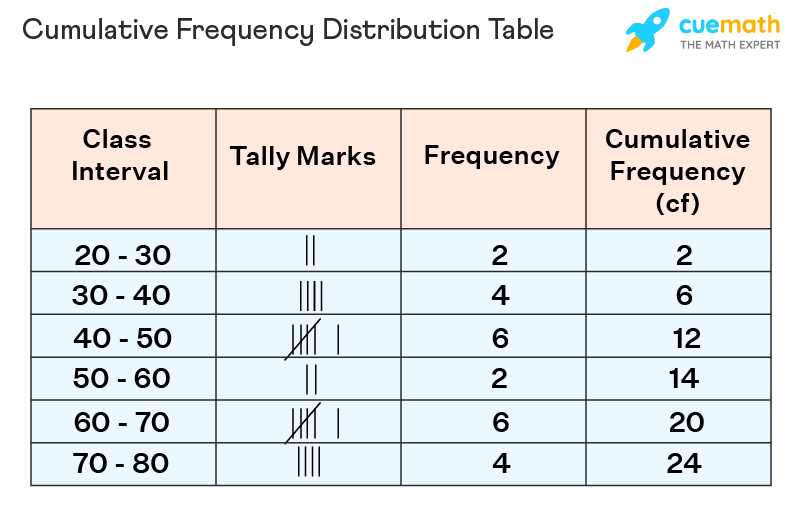
Coefficient of variation
the ratio of the standard deviation to the mean. The higher the value, the greater the level of dispersion around the mean. It is generally expressed as a percentage.

Box and Whisker outlier boundaries
Lower Bound: Q1−1.5×IQR
-anything below this number
Upper Bound: Q3+1.5×IQR
-anything above this number
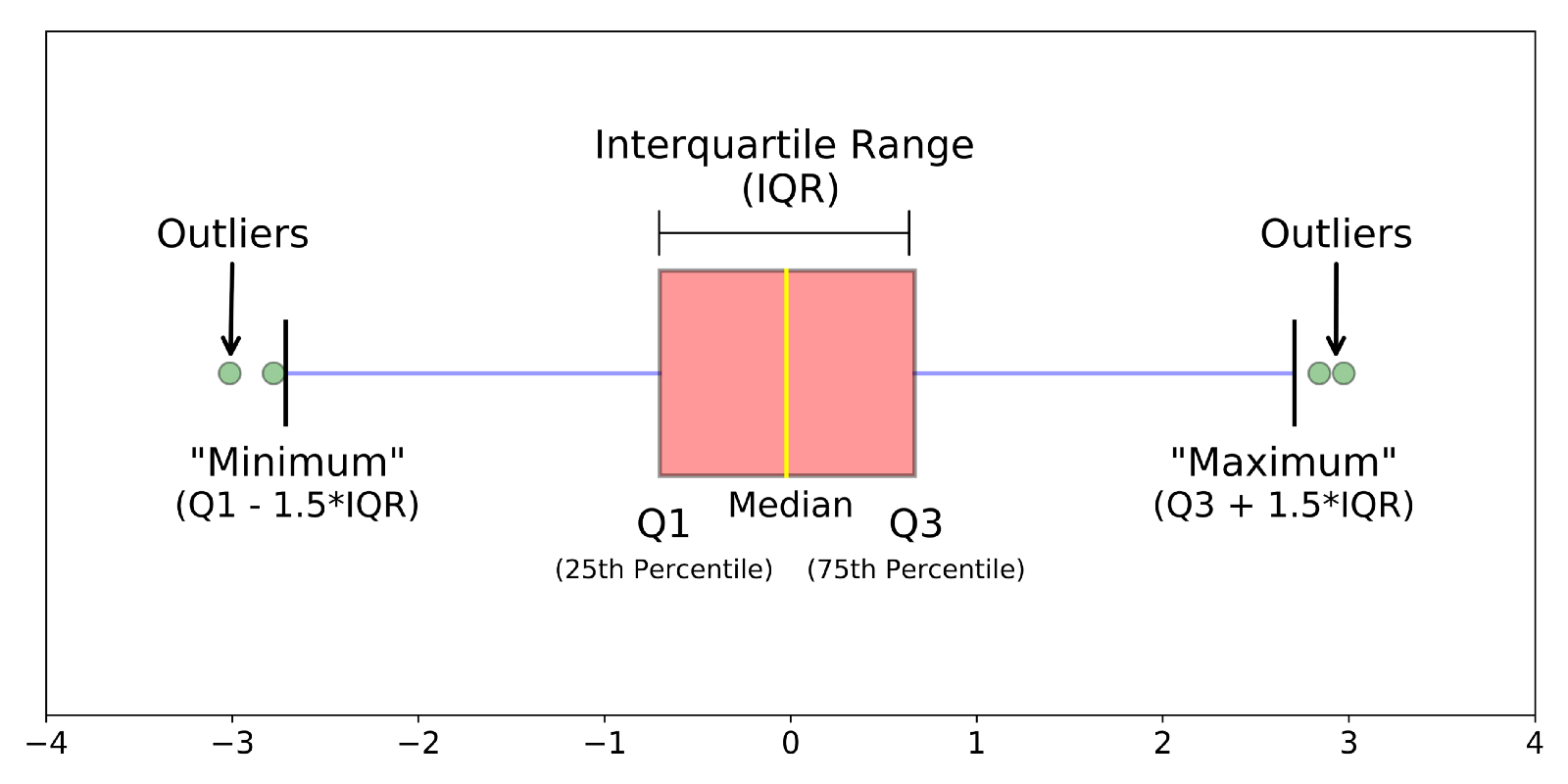
Sensitivity
a measure of how well a test can identify people who have a condition or outcome
=P(Test Positive | Has Disease)
= Number who tested positive and have disease / Total number who have disease
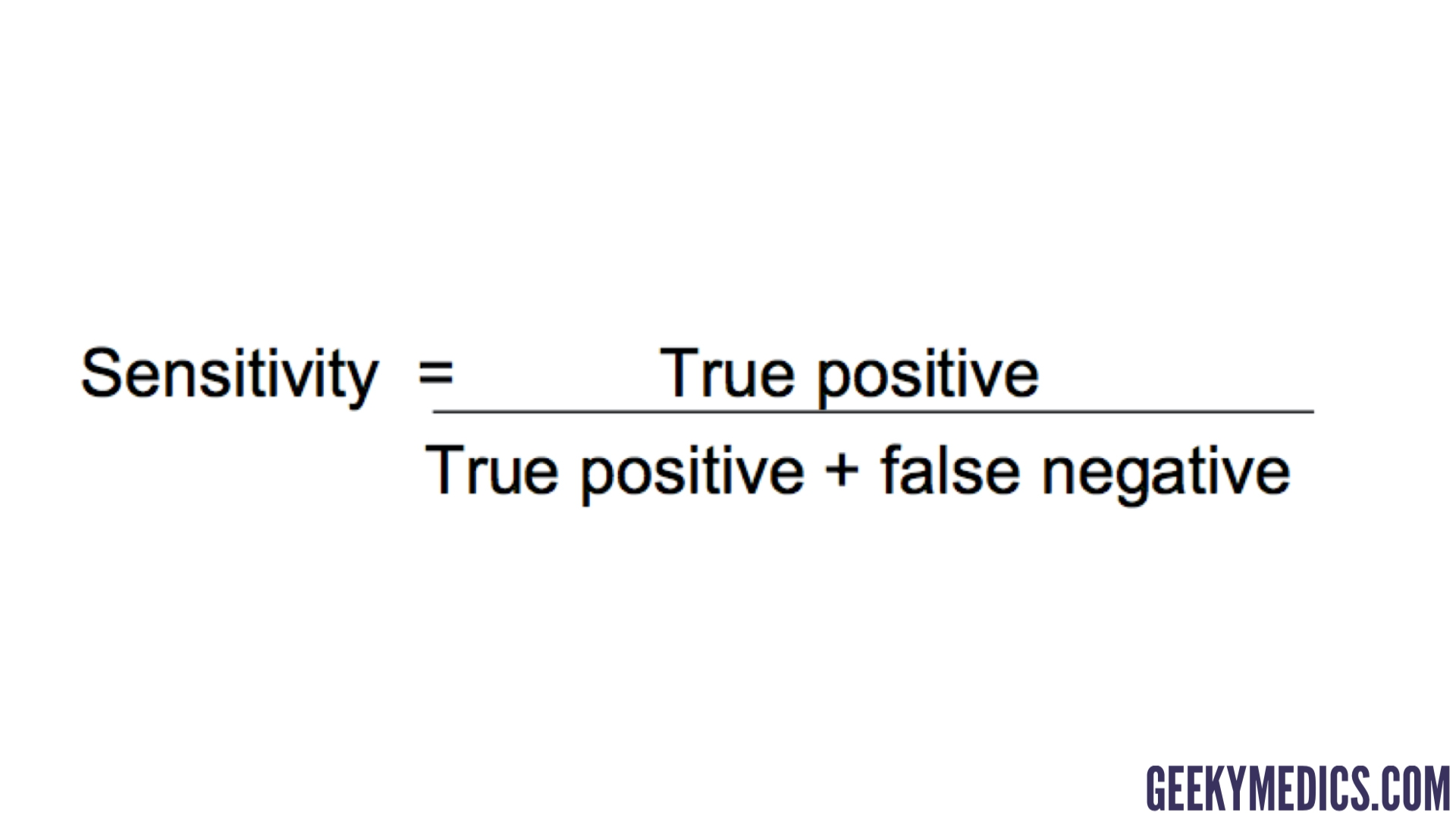
Specificity
a statistical measure of how well a test can identify people who do not have a condition
P(Test Negative | No Disease)
= Number who tested negative and don’t have disease / Total number who don’t have disease
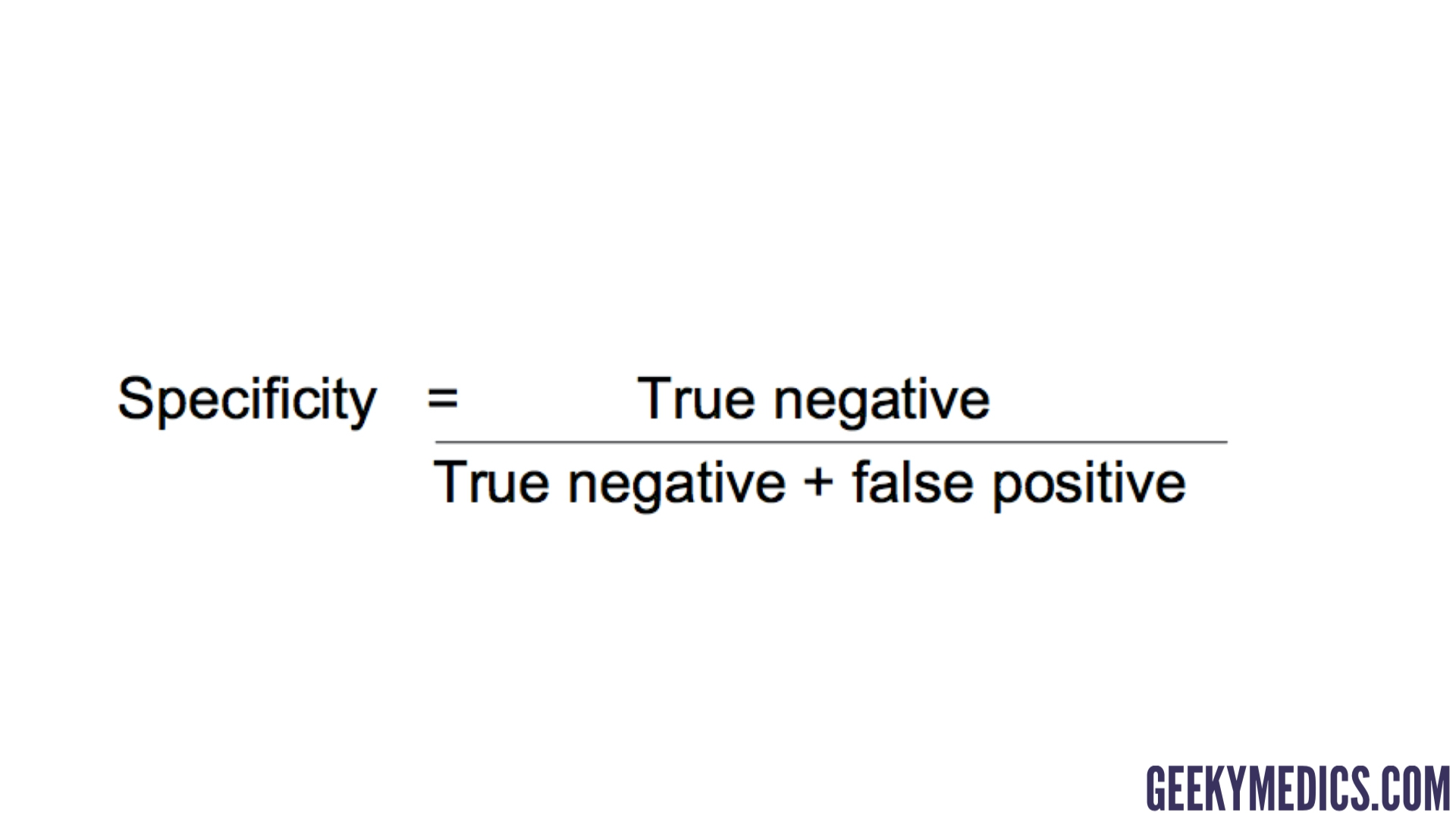
Predictive value positive
a statistical measure that indicates the probability of a positive test result correctly identifying a disease or condition
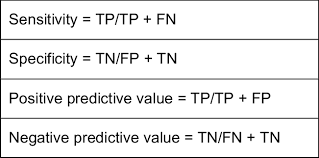
Predictive value negative
the probability that someone with a negative test result is actually free of disease
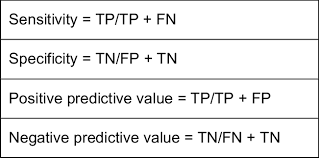
Bayes’ theorem
a mathematical formula that calculates the probability of an event based on prior knowledge
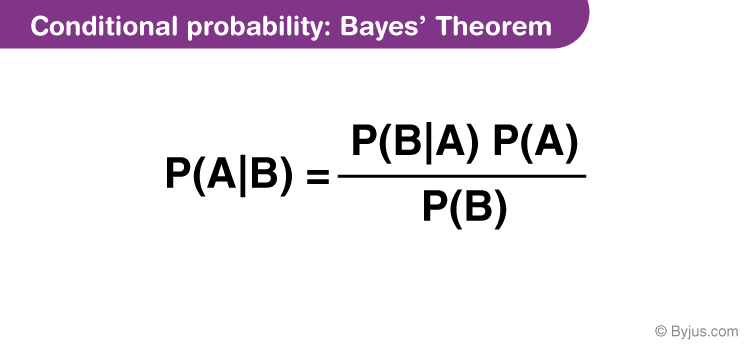
Complement probability
the probability that the event does not occur
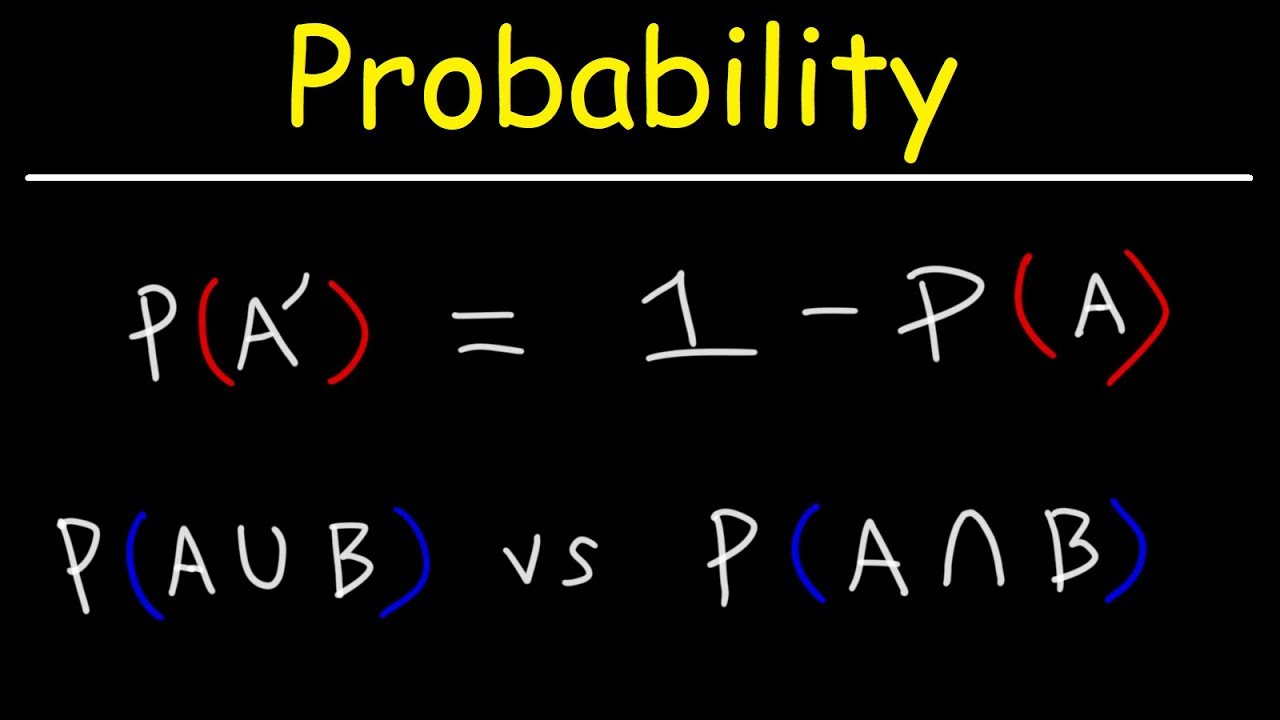
Addition rule
to find the probability of either event A or event B occurring, you add the individual probabilities of each event, then subtract the probability of both events occurring simultaneously
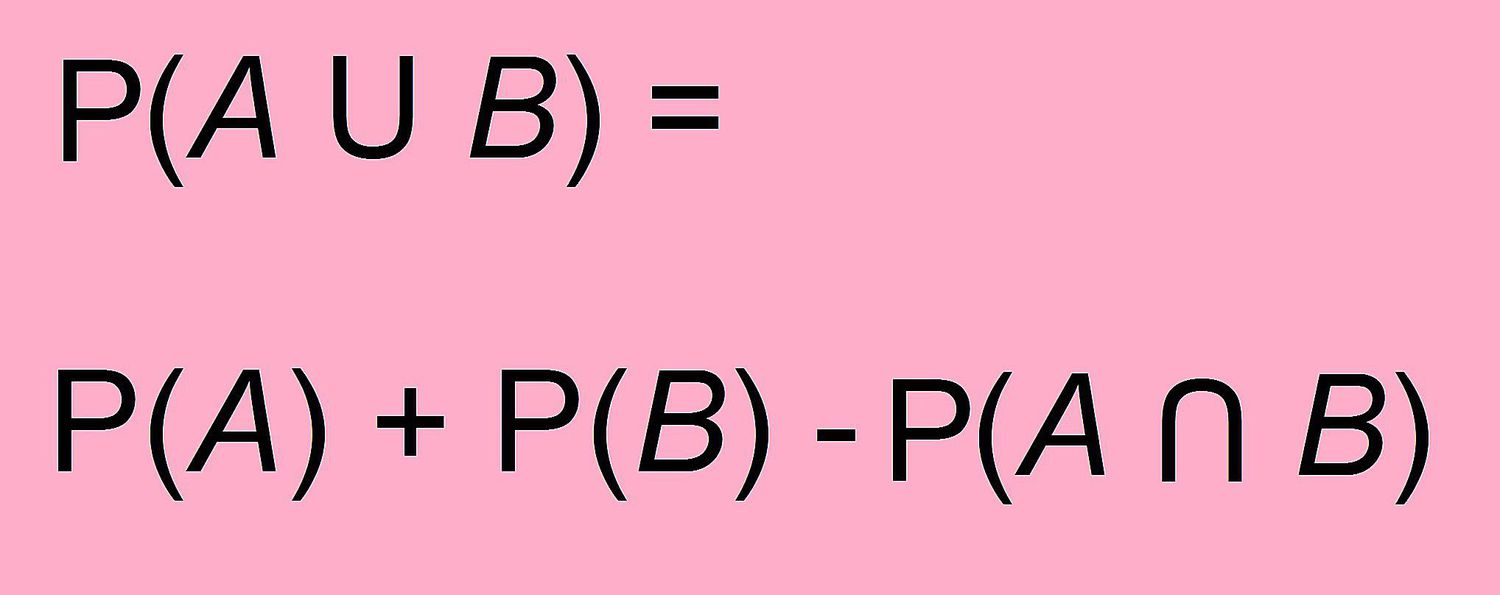
Multiplication rule
the probability of two (or more) independent or dependent events occurring together can be found by multiplying their individual probabilities.
Quick Test for Independence:
Calculate P(A)×P(B).
Compare it to P(A and B)
If they are equal, the events are independent.
If they are not equal, the events are dependent.
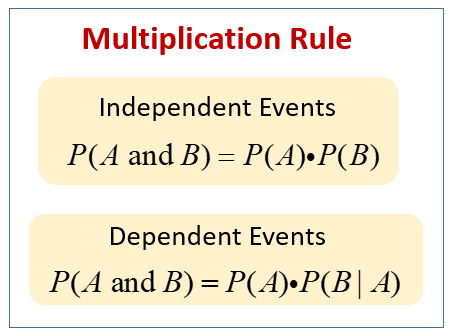
Class interval widths
1. Identify the Range of the Data
The range is the difference between the maximum and minimum values in your data set
2. Choose the Number of Classes
The number of classes (k) can be chosen based on guidelines such as Sturges' Rule:
k=1+3.322log n where n is the number of data points.
Alternatively, you can choose a reasonable number of classes (usually between 5 to 20, depending on the data size).
3. Calculate the Class Width
The class width (w) is calculated as:
w=Range/number of classes
Round up the class width to a convenient number for easy interpretation.
If you get a decimal, round up to the next whole number to ensure full coverage.
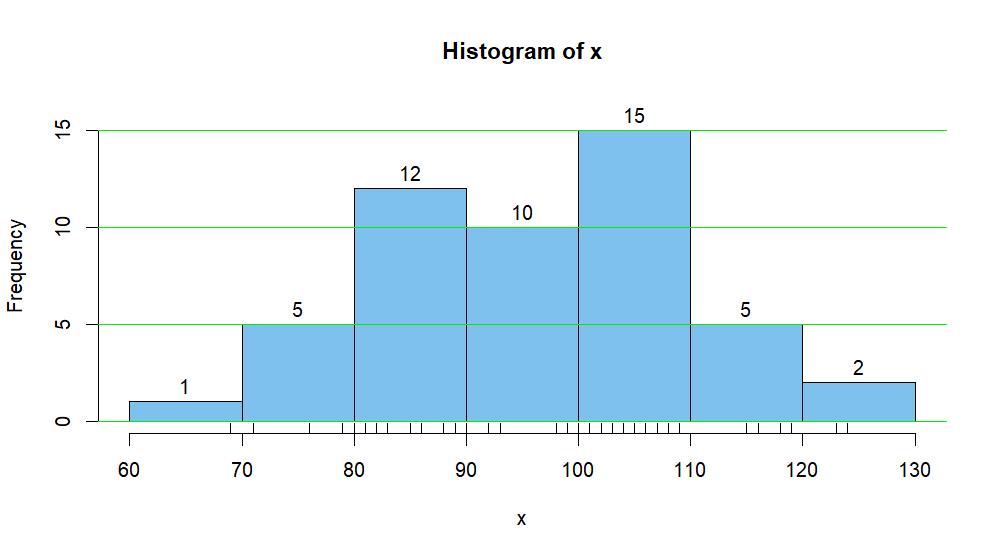
Measurement scales
1. Nominal Scale
Definition: Categorizes data without any order.
Characteristics:
Names, labels, or categories only
No ranking or meaningful order
Can't do arithmetic on them
Examples:
Gender (male, female, other)
Blood type (A, B, AB, O)
Eye color (blue, brown, green)
🔸 2. Ordinal Scale
Definition: Categorizes data with a meaningful order, but the differences between categories are not measurable or consistent.
Characteristics:
Ranked or ordered
Intervals are not equal or meaningful
Arithmetic is not valid
Examples:
Survey ratings (satisfied, neutral, dissatisfied)
Education level (high school, bachelor's, master's)
Class rankings (1st, 2nd, 3rd)
🔹 3. Interval Scale
Definition: Numerical data with meaningful differences between values, but no true zero point.
Characteristics:
Ordered and equally spaced
No absolute zero (zero does not mean "none")
Ratios don’t make sense
Examples:
Temperature in °C or °F (0° ≠ "no temperature")
IQ scores
Dates on a calendar
🔸 4. Ratio Scale
Definition: Like the interval scale, but has a true zero, so ratios are meaningful.
Characteristics:
Ordered, equal intervals, and a true zero point
All arithmetic operations are valid
Examples:
Age
Height
Weight
Distance
Time duration
Money
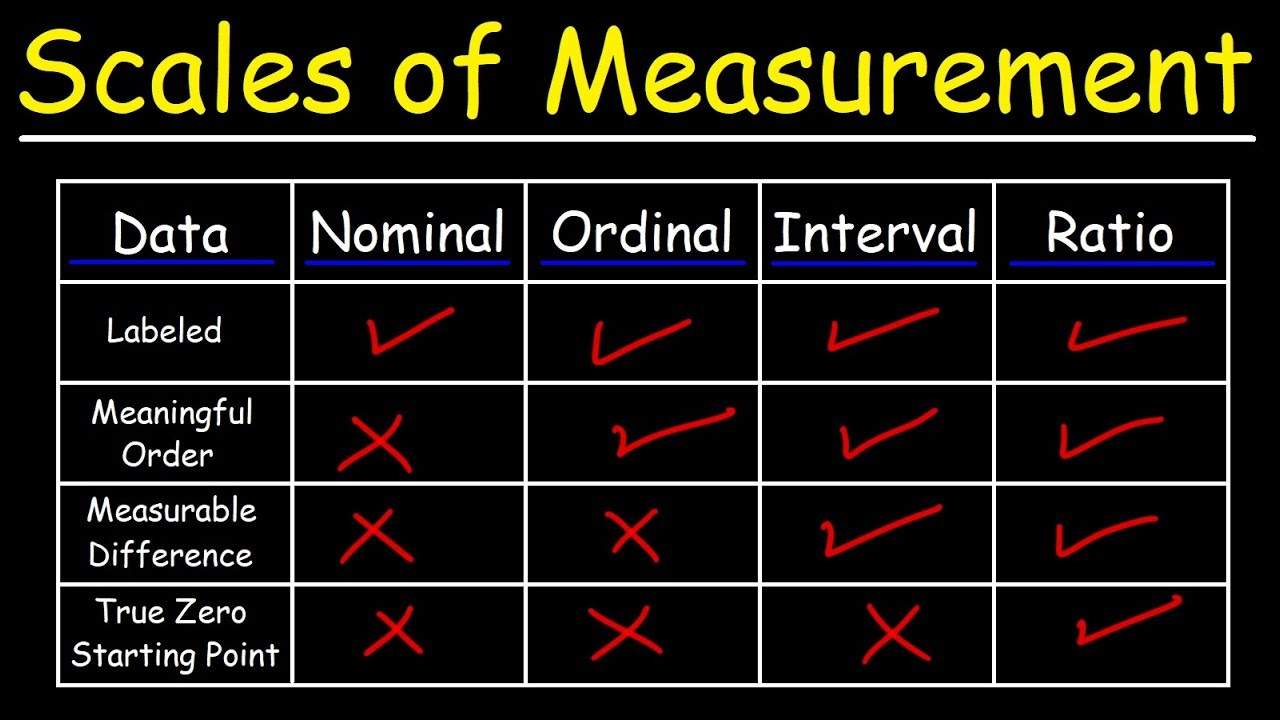
Cumulative frequency
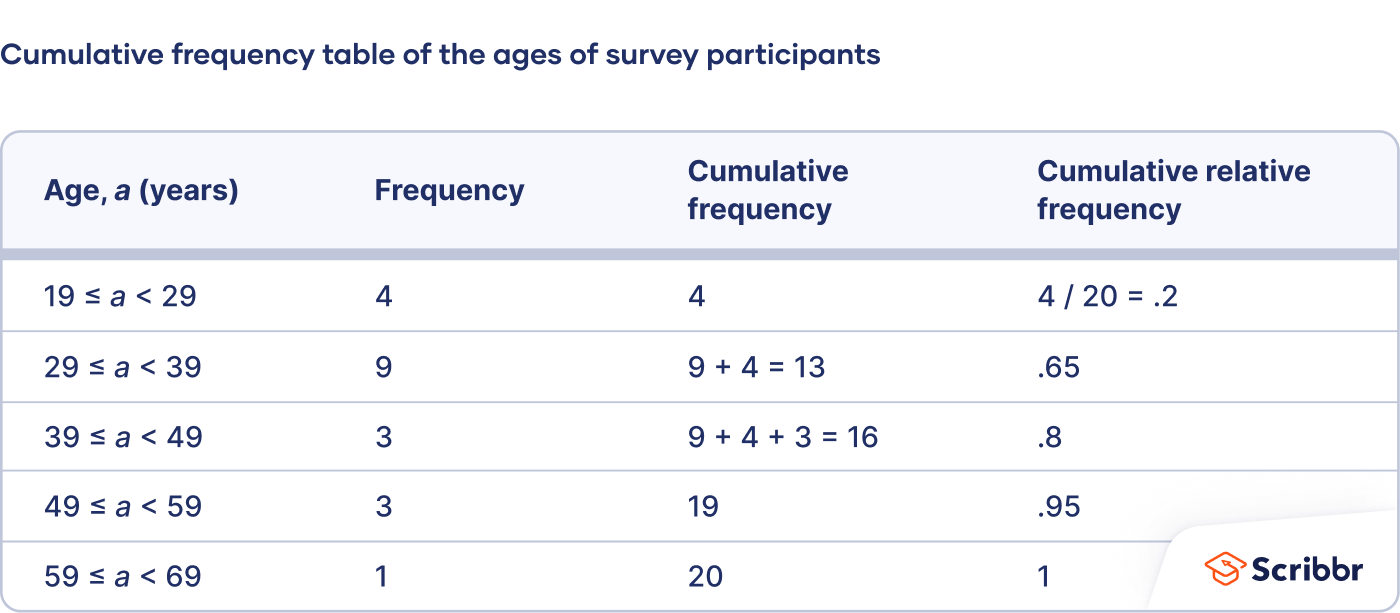
Sturges rule
-an equation to help one choose the number of bins in a histogram or frequency distribution which helps organize the data into a clear representation without it being too broad or too restricted
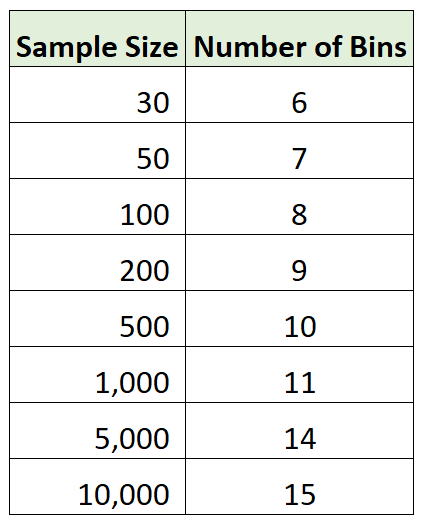
Which graphs provide a smooth vision of the data?
Histogram & Box and whisker
Which graph best shows interval spacings between data points?
dot plots
Which graph(s) can handle a large amount of data over a large range of values?
-Stem & Leaf
-Histogram
-Box & whisker
Median position for odd sample sizes

P(AUB) (“or” probability)
= P(A) + P(B)- P(ANB)
Bell shaped graph
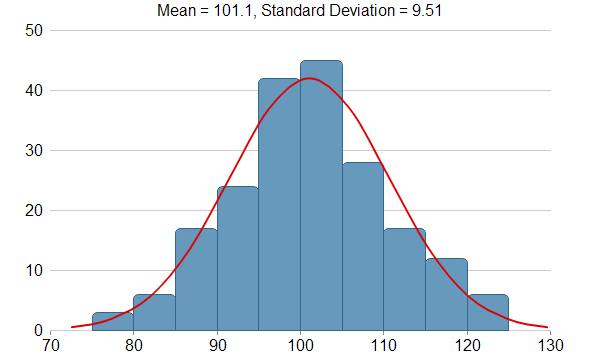
Uniform histogram
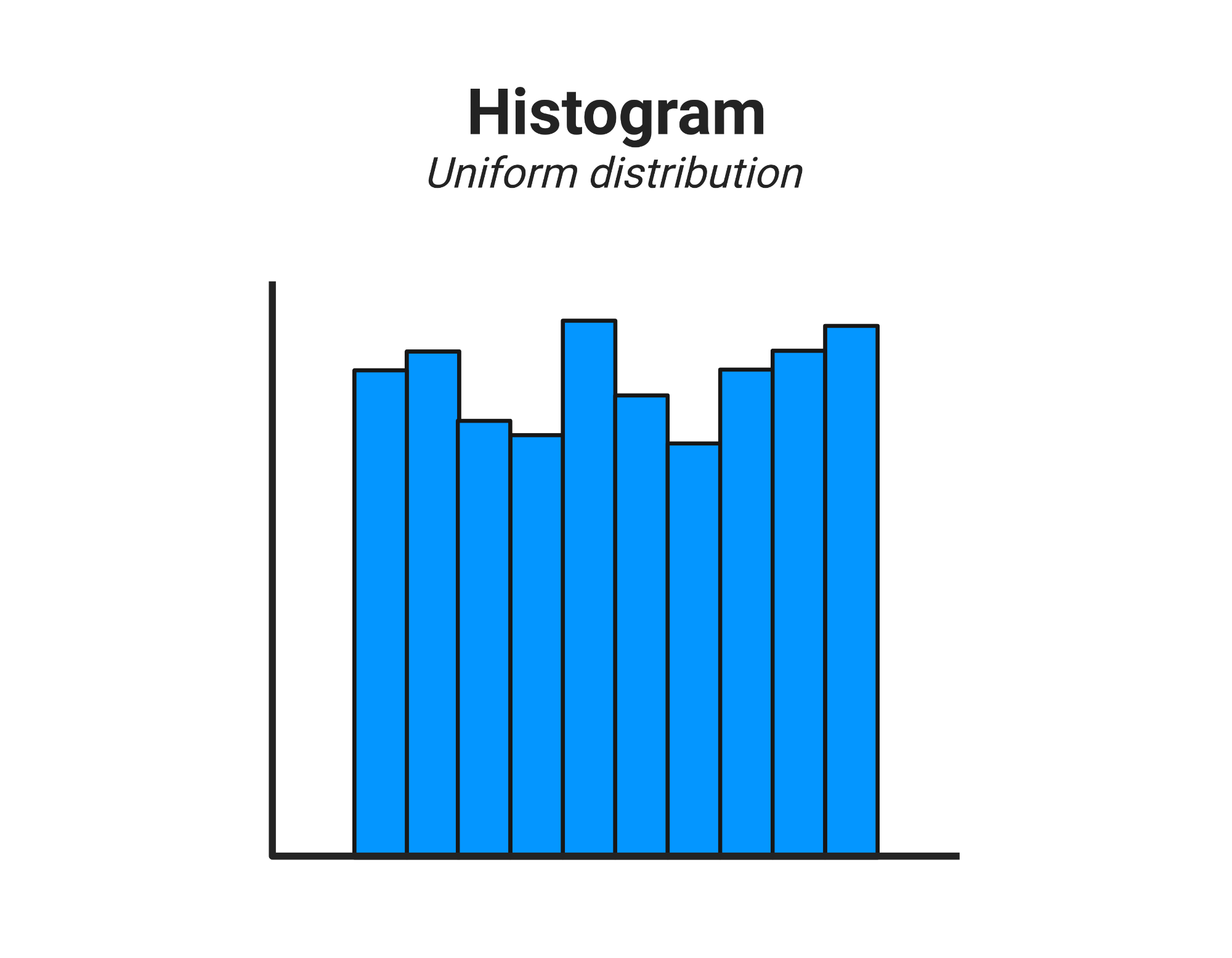
False positive
= P(Test Positive | No Disease)
= Number who tested positive but don’t have disease / Total number who don’t have disease